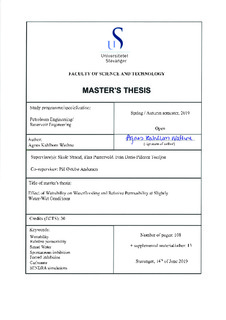| dc.contributor.advisor | Strand, Skule | |
| dc.contributor.advisor | Puntervold, Tina | |
| dc.contributor.advisor | Torrijos, Ivan Dario Pinerez | |
| dc.contributor.advisor | Andersen, Pål Østebø | |
| dc.contributor.author | Wathne, Agnes Kahlbom | |
| dc.date.accessioned | 2019-10-02T09:09:27Z | |
| dc.date.available | 2019-10-02T09:09:27Z | |
| dc.date.issued | 2019-06-14 | |
| dc.identifier.uri | http://hdl.handle.net/11250/2619821 | |
| dc.description | Master's thesis in Petroleum Engineering | nb_NO |
| dc.description.abstract | The wettability of a porous system is of high importance when waterflood behavior and relative permeability are investigated, because both will be strongly affected. Adsorption of polar organic components (POC) are responsible for wettability alteration towards an oil-wet state. In carbonate reservoir, the acidic POC plays a major role for the initial wettability. This study aims to improve the understanding of initial wettability on oil recovery and if the experimental data can be further used to evaluate relative permeability curves for wettability alteration processes by Smart Water.
In this experimental work, chalk material from Stevns Klint was used to evaluate the effect of initial wettability on unsteady state relative permeability estimations. Two chalk cores were prepared to be strongly water-wet and used as reference cores, while two other cores were prepared to be mixed-wet by flooding the restored cores with crude oil with POC at Swi=20%. The acid number of the crude oil was, AN=0.67 mgKOH/g. A mineral oil without POC was introduced to both systems, to ensure that the experiments were performed under the same conditions. Oil recovery tests by forced- and spontaneous imbibition were conducted on the cores at 23C. The effect of adsorption of polar organic components on initial wettability were investigated by spontaneous imbibition (SI), while the fraction of water-wet surface area was measured by a chromatographic wettability test. It was further investigated if reliable relative permeability curves could be modelled by the software SENDRA based on the experimental data.
The oil production by forced imbibition (FI) for both systems showed favorable mobility conditions for high displacement efficiency, and over 70 %OOIP were produced for both systems. Active capillary forces were observed in all cores during both oil recovery tests. The reference cores were confirmed to be strongly water-wet as the FW imbibed rapidly and a recovery plateau was reached after only hours. The cores exposed to crude oil were confirmed to be less water-wet, i.e., fractional-wet. Reliable relative permeability curves were modelled only for the strongly-water wet system. In conclusion, only one set of reliable relative permeability curves for the wettability alteration process by Smart Water were modelled based on experimental data. | nb_NO |
| dc.language.iso | eng | nb_NO |
| dc.publisher | University of Stavanger, Norway | nb_NO |
| dc.relation.ispartofseries | Masteroppgave/UIS-TN-IER/2019; | |
| dc.rights | Navngivelse 4.0 Internasjonal | * |
| dc.rights.uri | http://creativecommons.org/licenses/by/4.0/deed.no | * |
| dc.subject | SENDRA | nb_NO |
| dc.subject | petroleumsteknologi | nb_NO |
| dc.subject | reservoarteknologi | nb_NO |
| dc.subject | wettability | nb_NO |
| dc.subject | relative permeability | nb_NO |
| dc.subject | smart water | nb_NO |
| dc.subject | spontaneous imbibition | nb_NO |
| dc.subject | forced imbibition | nb_NO |
| dc.subject | carbonate | nb_NO |
| dc.subject | petroleum technology | nb_NO |
| dc.subject | reservoir engineering | nb_NO |
| dc.title | Effect of Wettability on Waterflooding and Relative Permeability at Slightly Water-Wet Conditions | nb_NO |
| dc.type | Master thesis | nb_NO |
| dc.subject.nsi | VDP::Technology: 500::Rock and petroleum disciplines: 510::Petroleum engineering: 512 | nb_NO |

